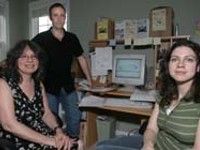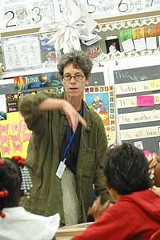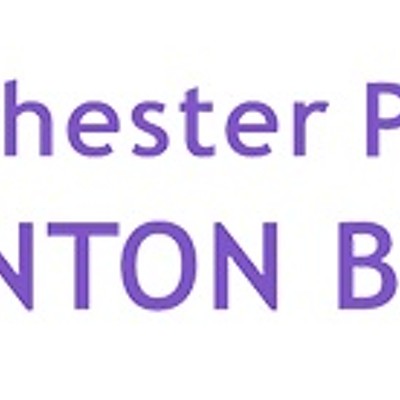Big needs, big rewards… big costs
Educating Rochester’s children with special needs
By Jennifer Weiss[
{
"name": "500x250 Ad",
"insertPoint": "5",
"component": "15667920",
"parentWrapperClass": "",
"requiredCountToDisplay": "1"
}
]
About this series
Throughout the spring, the Rochester school district struggled to close a large shortfall in its 2004-05 budget. It also struggled to fight off critics' charges that the district spends too much money --- that its per-pupil cost is too high, that its costs are rising dramatically, despite its declining enrollment.
In this continuing series, "Caught in the Middle," City Newspaper explores both the critics' concerns and the district's challenges.
This week: one of the district's most expensive components, the education of city children with special needs.
Of the 33,832 students children attending Rochester schools this past year, 5,819 were "special-education" students. Some have behavioral problems that hinder their learning and sometimes disrupt classes. Others have physical and mental illnesses and disabilities --- some so severe that in addition to a teacher, the district must provide an adult to sit beside them throughout the day to help them speak, write, or walk.
The district is required by law to provide these services. It also pays for the administrators who oversee the specialized staff. It pays for the staff that assesses the students' needs, meets with parents, assigns the students to schools, determines whether they can be "mainstreamed" --- attend class with regular-ed children, the district's goal for as many children as possible --- or whether they need to be in a "self-contained" classroom, where students have more serious physical, mental, or behavioral problems.
(The names of the children have been changed to protect there privacy.)
It's time to do the Number Rock, and teacher Dory Driss builds excitement for the game before she presses "play" on the stereo.
"Are you ready, Naomi? Are you ready, LaShonda? Are you ready, Paul?" she says in the confident, cheerleading tone she's been using since 8:15 this morning and will continue using until 3 in the afternoon.
Children in this self-contained classroom at School 29, in the city's southwest area, have multiple handicapping conditions. One, a boy who stares at Driss looking alternately joyful and bewildered, has cerebral palsy. He has trouble speaking, has some hearing loss, and wears braces on his legs. A girl to his left, who sits in a wheelchair, also has cerebral palsy, is mildly retarded, and has vision problems. She's grinning, flailing her arms, and moving her head back and forth to the beat of the music coming from the stereo.
Both need help turning pages in books. They need help moving around the large classroom. They even need help calling out "bingo!" when they've won a game. Paraprofessionals assist them, sitting beside or behind the two children all day. In Driss's room, six paras assist 13 children, and several have these one-on-one relationships.
Other children in the room are hemiplegic or quadriplegic. Some have ADHD --- attention deficit hyperactivity disorder --- autism, emotional problems, and other developmental disorders that affect their social skills, motor skills, and language development. Some are dependent in all ADLs --- adapted skills of daily living --- which means they need assistance eating, using the restroom, washing their hands.
Because some of the students are hearing impaired or completely nonverbal, Driss spends part of her day communicating in sign language and finger spelling.
The students' education with Driss, who has taught at School 29 for the past 31 years, is some of the first schooling these kindergarteners, first- and second-graders have ever had.
It's Ricky's turn to perform the Number Rock in front of his classmates. "Use this as a pointer," Driss says, handing him a pencil, "and be gentle."
When the music starts, Driss holds Ricky's wrist to help him point to the numbers being sung. "One, two!" the recording sings.
"One, two!" the children scream back excitedly.
"Three, four, five!"
"Three, four, five!"
The classroom is full of voices --- shouts and squeaks, lilts and shrieks. Some of the children dance in their seats. Alison, one such dancer, moves her head to the beat, and the plastic clack of white and silver beads in her braided hair adds to the music.
When the rock is finished, Driss announces that it's time for alphabet bingo. Two paraprofessionals help distribute the materials. The transition between activities is seamless, and the game begins.
In the early 1990s, School 29 had many more children with special needs than it does today. Since then, Principal Eldridge Moore says, many have been moved to other buildings. The school now has 128 special-ed and 386 regular-ed children.
There are 11 "inclusion classrooms" --- rooms in which children with handicapping behavioral or physical conditions attend class with their regular-ed peers. There are two self-contained rooms for children with multiple handicapping conditions --- Driss's and another for children in grades three to five, each with a teacher and several paraprofessionals. In three other self-contained rooms, a teacher and a smaller number of paras work with a dozen special-ed children, some of whom have behavioral and emotional problems.
In all, School 29 has 22 regular-ed teachers, 10 special-ed teachers, and 23 paras. In addition, a handful of teachers teach specialized subjects like art, music, gym, and speech. A librarian, a nurse, and a nurse's aid are also on staff.
The federal Individuals with Disabilities Education Act guarantees disabled students a "free appropriate public education." In the Rochester School District, it costs an average of $17,997 to educate a special-needs child, compared to $6,091 for a regular-needs child. (These totals don't include transportation costs, debt service, or the salaries and benefits of district-wide administrators, and are the numbers the state uses to report on school district expenditures.)
Moore wants School 29 known as a school with great extracurricular programs, rather than "a special ed school." One after-school program, provided through a partnership with the Boys & Girls Club of Rochester, lets students stay until 6 o'clock every day for recreation, art projects, drama, dance, guest speakers, and a hot meal. Another program, Lawyers for Learning, provides children with mentors and school supplies.
If you're one of School 29's roughly 500 students, Principal Moore seems larger than life. But beyond his height, athletic physique, and handsome suits is a guy who knows what it's like to grow up in your neighborhood. It was his neighborhood. He hung out with children like you near his home on Roslyn Street, and he shot hoops where you shoot hoops after school. His mom was the principal of your school once, before she retired and her son eventually took her place.
Moore, a graduate of Niagara University, played professional basketball for a year in Europe, then returned to Rochester, doing his student teaching --- at School 29 --- and getting his teacher's certificate at SUNY Geneseo.
He's been School 29's principal for two years, but this year was his last. Next year, he'll be principal at Edison Tech.
Down the hall from Driss's room, in Cheryl Fradenburgh's self-contained classroom, fifth-graders are preparing for the next day's overnight at the Rotary Sunshine Camp. A few of the six boys and one girl in the room right now are so excited they can't sit still.
As Fradenburgh goes through the basics --- what to bring, when they'll leave, and what they'll do when they get to camp --- Keisha repeats, "Miss Fradenburgh, Miss Fradenburgh, Miss Fradenburgh!" imploringly while Casey hops in and out of his seat.
There'll be swimming, Fradenburgh announces, and maybe even a boat ride.
Every child has a comment: "I don't like water on my head." "I don't have a swimsuit!" "What if I get chased?" "What if it rains?" "Who needs soap? My mom packed two soaps in my bag."
Casey hops up and stays standing this time, loudly announcing: "I'm not going on a boat. My uncle fell off a boat once and almost drowned."
Each of Frandenburgh's comments elicits a fresh outburst. Paraprofessionals Selena Johnson and Cheril White chime in from time to time, adding know-how, advice, or humor to the conversation.
Three paras work with the 12 children in Fradenburgh's class. Some of the students struggle with emotional problems and mental illness. A few suffer from bipolar disorder, which can cause shifts in their mood, energy level, and ability to function, while others have behavior disorders that can cause them to act out in class. Some of the children were suspended from other schools before they arrived in Fradenburgh's room.
Even lunchtime is spent in the classroom, with the adults ordering in and eating at a table while the children eat school-cafeteria lunches at their desks. She and the paras used to get lunch breaks, Fradenburgh says, but the children were too difficult to pacify after they spent whole lunch periods in the cafeteria.
Johnson, who says this year's class is her most challenging yet because of the difficulties the students face, has been a para for 30 years. Teachers from other classrooms send their children to her when they're in trouble, she says, because she has a reputation among the children for being tough as nails. While she talks the talk --- a witty sarcasm is peppered throughout her interactions with them --- Johnson is all heart.
"A lot of the children begin to start trusting you," she says, explaining why she loves her job. "They keep me young."
When it's time to work on a geography packet, Casey drops his head and arms onto the table and pretends to sleep. Johnson succeeds in rousing him, crossing to him and stopping just short of pulling him to his feet. "Come on a walk with me," she says in a tone that's more firm than friendly.
It works. "Ughhhhh," he replies as he leaves the room with her.
The children flip pages of stapled packets and begin to work on an exercise called "Merry Meridians." Some talk to each other and fidget, while one child explodes in a coughing fit.
"You need to spell instead of play," Fradenburgh tells one loud talker to keep him focused. "We're ready to move on to the next one. Little Rock is between which two meridians?"
They slide their fingers over their paper maps, looking for Arkansas, and shout their answers; 90 and 95 degrees is correct, Fradenburgh says after someone gets it right... but 90 and 95 degrees what?
They're stumped. Finally, Keisha figures it out. "West!" she exclaims.
"Good job," Fradenburgh says, smiling.
"I'm smart," Keisha announces proudly while the rest of the children write down the answer, then repeats --- "I'm smart, I'm smart, I'm smart, I'm smart" --- until Fradenburgh gives her the affirmation she's waiting for.
"Yes, you are," Fradenburgh says.
In Indrani Mitra's inclusion classroom, six of the 23 students have special behavioral and physical needs. One child, David, sits in a special chair called a Rifton chair, which provides support and stability for most of his body. A wooden knob between his legs keeps him from sliding out, and a small shelf keeps his feet from dangling uncomfortably. He wears a helmet, too, and walks slowly and unsteadily when he's removed from his seat by a paraprofessional.
David's para works with him one-to-one, entering his answers to math and language assignments into a laptop computer because he isn't able to write. Sometimes, he does independent language exercises using a modified keyboard with large letters that he can press.
The rest of the class is working on a writing assignment, making a portfolio of the numerous essays they've written over the course of the year. While they write, David, who has been helped out of his chair, wanders through the rows of desks and runs his palms along the walls. The other children sit in relative silence, pencils scratching, and don't even look up.
Mitra believes parental involvement can help turn low-achievers around. A parent's role in the classroom, in fact, is the subject of her doctoral thesis; she takes night classes at the Margaret Warner Graduate School of Education and Human Development at the University of Rochester.
Mitra tries to create what she calls a "trusting relationship" with parents at the very beginning of the school year, meeting them and inviting them to get involved. She draws upon her similarities with them to foster understanding and respect, she says. She tells them that education is important.
"Their socioeconomic situation is at the point where parents want the best but can't do much because they're working two jobs," she says. "But when I call them, they're there."
Her biggest challenges, she says, include children's inattentiveness, low motivation, cognitive problems, fighting, and talking back to her. Parental intervention, she says, often improves children' attitudes. "If parents monitor them, half the problems are solved," she says.
For example: the mother of one child had told him to hit back if somebody hit him, Mitra says. The right way to respond, she cautioned the child, was to tell an adult.
Then she called his mother.
"I told her: 'Maybe in the street, for survival skills. This is a school. It's a social setting,'" she says. "I told her son: 'If you continue with this behavior you'll be in such trouble that no one can save you.'"
School 29 has a large number of poor children. Mitra says that while she knows all of her students --- special-ed and regular-ed --- face challenges different from those of many of their peers in the suburbs, she believes they can match a suburban level of achievement. And she expects them to.
At the beginning of each school year, Mitra has her students pick an Ivy League school they'd like to attend some day. The school becomes the focal point of a collage they'll hang in their bedrooms, she says. The children put other pictures and words on the collage to remind themselves of the path they need to take to get to that school.
"Sometimes, it inspires them to do well," she says.
The door to Mitra's classroom is open. A boy standing in the doorway of another classroom shouts, "Go take your meds!" to another boy who just stepped out into the hall.
"You're the one who takes meds," the boy shouts back, then walks quickly away.
Back in Driss's room, the children are split up into groups she calls "centers," doing different supervised activities. A few, like Paul, are using some of the special learning equipment in the room. Others are using the kinds of games and toys you'd find in any classroom of this age level --- colorful magnetic letters, cards with pictures and words on them, a puzzle board with a Sesame Street theme.
After slipping Paul into a stander, a structure that supports his arms, legs, and back so he can stand upright, Driss wheels him to one of her classroom's two computers. She unwinds the cord of a large, plastic disc with a bright yellow top --- a special mouse Paul can use, with Driss's help, by applying pressure with his hand.
The instrument also records sound. Paul used it to participate in a group reading activity earlier in the year, pressing the button to say "Not I!" at certain prompts during a recording of The Little Red Hen.
"He's quiet today," Driss says of the boy with brown, wavy hair and inquisitive eyes, "but he's gotten very verbal."
Another student who has made great accomplishments this year is Calvin, Driss says. He now recognizes upper and lowercase letters, follows two-step directions, and attends to tasks for five to seven minutes without being verbally reminded. He's building his vocabulary, and using the visual schedule up at the front of the room to plan his day.
"Can you put a song in?" Calvin pleads, approaching Driss with puppy-dog eyes.
"Yes, Calvin," she says, smiling. "Just let me finish talking."
Ask Driss who or what she's been most proud of as a teacher at School 29, and she'll give you a list: a student who learned to walk and could eventually move freely around the school; a student who learned to speak and play with his classmates; a student with severe emotional problems who, over time, learned to control his behavior and not lash out at his peers.
"These things are hard to measure," she says, "but at the end of the day or year, that's what makes for a sense of accomplishment."
Speaking of...
Latest in News
More by Jennifer Weiss
-

To the streets: scenes from the protests
Sep 8, 2004 -

Communication between the communicators
Aug 4, 2004 -

Little political party is winning big
Aug 4, 2004 - More »








